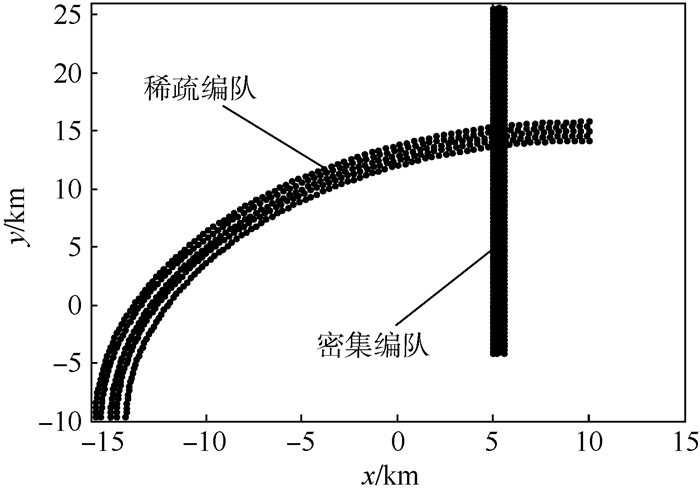-
摘要:
针对稳态编队在部分可辨条件下精细跟踪的难题,提出了一种基于迭代就近点(ICP)的稳态部分可辨编队精细跟踪算法。首先将ICP算法思想应用于编队成员拓扑的点航关联中,将
k 时刻的位置状态估计通过最近点循环迭代逼近k +1时刻的量测,在关联判决时采用双门限原则应对部分可辨所带来的漏观测问题,以提高关联时的容错性能;进而采用概率最近邻对漏观测航迹进行填补,以进一步保证跟踪的可靠性;最后,采用多模型法实现编队成员航迹滤波更新,以保证航迹的跟踪滤波精度。仿真结果表明,与现有的基于模版匹配的编队目标跟踪算法以及经典的多假设多目标跟踪算法相比,该算法具有较高的跟踪可靠性与精度,且在编队拓扑发生缓慢变化时具有更高的正确跟踪率。-
关键词:
- 部分可辨 /
- 稳态编队目标 /
- 迭代就近点(ICP) /
- 双门限 /
- 编队拓扑
Abstract:To deal with the problem of the refined tracking of steady groups in partly resolvable condition, a refined tracking algorithm based on iterative closest point (ICP) is proposed in this paper. First, the ICP algorithm is used in tracking association, and by using closest point cyclic iteration, the measurements at time
k +1 can be matched with the position estimation at timek . In order to deal with the problem of leakage tracks brought by partly resolvable group and to increase the fault tolerant performance in tracking association, double threshold principle is used in decision making. Then, to further ensure the reliability of tracking, probabilistic nearest neighbor method has been used to fill the leakage tracks. Finally, to ensure the precision of tracking, multi-model algorithm is used to realize filter update of group member tracking. The simulation results show that, compared with group target tracking algorithm based on template matching and classical multiple hypothesis tracking algorithm, the algorithm has better performance in tacking reliability and precision, and can be more accurate when slow change of group topology happens. -
表 1 各算法正确跟踪率对比(环境2)
Table 1. Comparison of correct tracking probability among different algorithms (Environment 2)
% 算法 第1次拓扑变化 第2次拓扑变化 ICP 88.5 63.4 TM 81.2 45.5 MHT 84.9 50.7 表 2 各算法平均处理时间对比(环境3)
Table 2. Comparison of average processing time among different algorithms (Environment 3)
ms 算法 稀疏编队 密集编队 ICP 0.516 0.477 TM 0.438 0.401 MHT 0.985 0.794 -
[1] 黄天俊. 低可观测目标的检测跟踪算法[D]. 西安: 西安电子科技大学, 2012: 1-3.HUANG T J.The algorithm of detection and tracking for low-observable target[D].Xi'an:Xidian University, 2012:1-3(in Chinese). [2] GVAN K, FGAN F.MHT extraction and track maintenance of a target formation[J].IEEE Transactions on Aerospace and Electronic System, 2002, 38(1):288-294. doi: 10.1109/7.993248 [3] 张昌芳. 阵群目标信息相关技术研究[D]. 长沙: 国防科学技术大学, 2009: 1-10.ZHANG C F.Research on data association method of group data[D].Changsha:National University of Defense Technology, 2009:1-10(in Chinese). [4] 赵志超, 饶彬, 王雪松, 等.基于概率网格Hough变换的多雷达航迹起始算法[J].航空学报, 2010, 31(11):2209-2215. http://www.cnki.com.cn/Article/CJFDTOTAL-HKXB201011016.htmZHAO Z C, RAO B, WANG X S, et al.Multi-radar track initiation algorithm based on probabilistic Hough transform[J].Acta Aeronautica et Astronautica Sinica, 2010, 31(11):2209-2215(in Chinese). http://www.cnki.com.cn/Article/CJFDTOTAL-HKXB201011016.htm [5] 何友, 修建娟, 张晶炜, 等.雷达数据处理及应用[M].2版.北京:电子工业出版社, 2009:121-293.HE Y, XIU J J, ZHANG J W, et al. Radar data processing with applications[M]. 2nd ed. Beijing:Publishing House of Electronics Industry Press, 2009:121-293(in Chinese). [6] WANG H L, WANG D S, TIAN L S.A new algorithm for group tracking[C]//2011 CIE International Conference on Radar.Xi'an:[s.n.], 2011:1159-1163. [7] 何友, 王海鹏, 熊伟, 等.基于相对位置矢量的灰色精细航迹起始算法[J].航空学报, 2012, 33(10):1850-1863. http://www.cnki.com.cn/Article/CJFDTOTAL-HKXB201210013.htmHE Y, WANG H P, XIONG W, et al.Refined gray track initiation algorithm of group targets based on relative position vectors[J].Acta Aeronautica et Astronautica Sinica, 2012, 33(10):1850-1863(in Chinese). http://www.cnki.com.cn/Article/CJFDTOTAL-HKXB201210013.htm [8] 邢凤勇, 熊伟, 王海鹏.基于聚类和Hough变换的多编队航迹起始算法[J].海军航空工程学院学报, 2010, 25(6):624-629. http://www.cnki.com.cn/Article/CJFDTOTAL-JZCK201111051.htmXING F Y, XIONG W, WANG H P.A formation target track initiation algorithm based on clustering and Hough transform[J].Journal of Naval Aeronautical and Astronautical University, 2010, 25(6):624-629(in Chinese). http://www.cnki.com.cn/Article/CJFDTOTAL-JZCK201111051.htm [9] 耿文东.基于PDA的群目标合并与分离方法研究[J].无线电工程, 2007, 37(2):24-27. http://www.cnki.com.cn/Article/CJFDTOTAL-WXDG200702008.htmGENG W D.A study on group target merging and splitting method based on PDA[J].Radio Engineering, 2007, 37(2):24-26(in Chinese). http://www.cnki.com.cn/Article/CJFDTOTAL-WXDG200702008.htm [10] 刘红, 耿文东.基于模式空间的群目标合并与分离方法研究[J].无线电工程, 2010, 40(2):53-56. http://www.cnki.com.cn/Article/CJFDTOTAL-WXDG201002019.htmLIU H, GENG W D.A study of merging and splitting methods for group targets based on pattern space[J].Radio Engineering, 2010, 40(2):53-56(in Chinese). http://www.cnki.com.cn/Article/CJFDTOTAL-WXDG201002019.htm [11] FRANCOIS S, SZE K P. Tracking of coordinated groups using marginalized MCMC-based particle algorithm[J].IEEE Transactions on Automatic Control, 2009, 31(2):1-11. http://ieeexplore.ieee.org/xpls/icp.jsp?arnumber=4839491 [12] 连峰, 韩崇昭, 刘伟峰, 等.基于SMC-PHDF的部分可分辨的群目标跟踪算法[J].自动化学报, 2010, 36(5):731-741. http://www.cnki.com.cn/Article/CJFDTOTAL-MOTO201005014.htmLIAN F, HAN C Z, LIU W F, et al.Tracking partly resolvable group targets using SMC-PHDF[J].Acta Automatica Sinica, 2010, 36(5):731-741(in Chinese). http://www.cnki.com.cn/Article/CJFDTOTAL-MOTO201005014.htm [13] MIHAYLOVA L, GNING A.Group object structure and state estimation in the presence of measurement origin uncertainty[C]//2009 IEEE/SP 15th Workshop on Statistical Signal Processing.Piscatawey, NJ:IEEE Press, 2009:473-476. [14] FELDMANN M, FRANKEN D.Advances on tracking of extended objects and group targets using random matrices[C]//2009 12th International Conference on Information Fusion.Piscatawey, NJ:IEEE Press, 2009:1029-1036. [15] LIAN F, HAN C Z, LIU W F.Sequential monte carlo implementation and state extraction of the group probability hypothsis density filter for partly unresolvable group targets-tracking problem[J].IET Radar, Sonar and Navigation, 2010, 4(5):685-702. doi: 10.1049/iet-rsn.2009.0109 [16] 王海鹏, 熊伟, 何友, 等.集中式多传感器群目标灰色精细航迹起始算法[J].系统工程与电子技术, 2012, 34(11):2249-2255. doi: 10.3969/j.issn.1001-506X.2012.11.11WANG H P, XIONG W, HE Y, et al.Gray refined track initiation algorithm for centralized multi-sensor group targets[J].System Engineering and Electronics, 2012, 34(11):2249-2255(in Chinese). doi: 10.3969/j.issn.1001-506X.2012.11.11 [17] 王海鹏, 董云龙, 熊伟, 等.运动状态下多传感器群目标精细航迹起始算法[J].宇航学报, 2012, 33(11):1690-1698. doi: 10.3873/j.issn.1000-1328.2012.11.019WANG H P, DONG Y L, XIONG W, et al.Multi-sensor group target refined track initiation algorithm based on moving state[J]. Journal of Astronautics, 2012, 33(11):1690-1698(in Chinese). doi: 10.3873/j.issn.1000-1328.2012.11.019 [18] PANG S K, LI J, GODSILL S J.Detection and tracking of coordinated groups[J].IEEE Transcations on Aerospace and Electronic Systems, 2011, 47(1):472-502. doi: 10.1109/TAES.2011.5705687 [19] 王海鹏. 多传感器编队目标跟踪算法研究[D]. 烟台: 海军航空工程学院, 2012: 71-85.WANG H P.Study of multi-sensor group targets tracking algorithm[D].Yantai:Naval Aeronautical and Astronautical University, 2012:71-85(in Chinese). [20] 祝继华, 郑南宁, 袁泽剑, 等.基于ICP算法和粒子滤波的未知环境地图创建[J].自动化学报, 2009, 35(8):1107-1113. http://www.cnki.com.cn/Article/CJFDTOTAL-MOTO200908013.htmZHU J H, ZHENG N N, YUAN Z J, et al.A SLAM approach by combibing ICP algorithm and particle filter[J].Acta Automatica Sinica, 2009, 35(8):1107-1113(in Chinese). http://www.cnki.com.cn/Article/CJFDTOTAL-MOTO200908013.htm [21] 宋强. 目标航迹对准关联与传感器系统误差估计技术研究[D]. 烟台: 海军航空工程学院, 2010: 33-39.SONG Q.Target track alignment-correlation and sensor bias estimation technique research[D].Yantai:Naval Aeronautical and Astronautical University, 2010:33-39(in Chinese). [22] 何友, 王国宏, 关欣.信息融合理论及应用[M].北京:电子工业出版社, 2010:189-193.HE Y, WANG G H, GUAN X.Information fusion theory with applications[M].Beijing:Publishing House of Electronics Industry, 2010:189-193(in Chinese). -







 下载:
下载:






